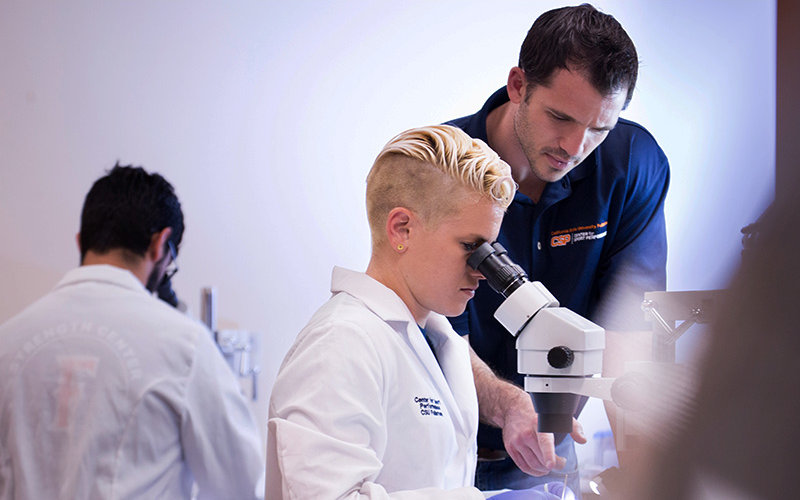
A recently completed study by Cal State Fullerton researchers has found results that seemingly contradict current thoughts on muscle development, specifically “fast-twitch” skeletal muscle fibers in elite female weightlifters.
Fast-twitch muscles fibers are used in speed activities speed and resistance activities, such as sprinting, and resistance actions, like weightlifting and other strength sports. Slow-twitch muscles are used in endurance, actions such as long-distance running.
The exploration of muscle cells at the molecular level focused on fibers in speed, power and strength-trained individuals — something that has rarely been studied and even rarer with the emphasis on females, says Andrew Galpin, one of the study authors and a Cal State Fullerton associate professor of kinesiology.
“And we found the elite female weightlifters had a higher concentration of fast-twitch muscle fibers than any elite athlete, man or woman, in any sport.”
“Women are understudied in general and the science is cripplingly bad when it comes to studying the female athlete. We need to know the differences in women’s muscle, so that we can optimize their training.
“It’s been long known that women generally have more slow-twitch fibers and men more fast-twitch fibers,” explained Galpin. “The difference has been put down to evolutionary changes.
“But we found the direct opposite when looking at muscle fibers taken from elite female weightlifters … we found the females had far more fast-twitch muscles than seen in male weightlifters,” he added.
“And we found the elite female weighlifters had a higher concentration of fast-twitch muscle fibers than ever recorded for any elite athlete, man or woman, in any sport.”
The finding, he added, “kills the myth that women are not predisposed to being good at these types of exercises. Clearly, from a cellular level, some women are extraordinarily geared to be hyper strength/power athletes.”
The researchers focused on elite World/Olympic and national-caliber American weightlifters to “know where to set the goal posts” in the spectrum of human potential, the kinesiologist explained.
Galpin says the Cal State Fullerton faculty authors and a new wave of graduate students will continue to analyze the data from this study and then move to the next step, studying different training methods to find what works and what doesn’t in strength-training for male and female weightlifters.
“We need to know the differences in women’s muscle, so that we can optimize their training.”
The paper, “Extraordinary Fast-Twitch Fiber Abundance in Elite Weightlifters,” was a collaboration involving Cal State Fullerton kinesiology faculty Andrew Galpin, Robert Lockie and Pablo Costa; CSUF alumni Nathan Serrano ’18 (M.S. kinesiology), Kara Lazauskas ’19 (M.S. kinesiology) and Jeremy Siu ’19 (B.S. kinesiology-clinical movement science) working in the university’s Center for Sport Performance; James Bagley of San Francisco State University; and Lauren Colenso-Semple, a teaching and research associate at the University of South Florida. It was published today (March 27) in PLOS One, an open-source, peer-reviewed journal.